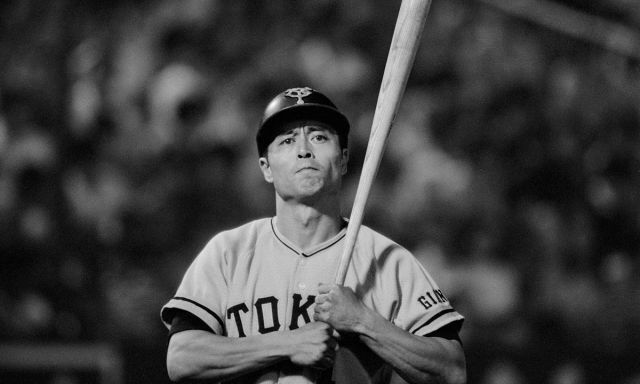-
Posts
113 -
Joined
-
Last visited
Content Type
Profiles
Forums
Downloads
Posts posted by mrg1
-
-
Sadaharu Oh
From wikipedia:
Sadaharu Oh was a professional baseball player and manager. He is one of Japan's most revered sports heroes, although he has never had Japanese citizenship and holds a Republic of China passport. His Chinese name is Wang Zhenzhi
Oh was born in Tokyo, Japan, was the son of a Chinese father and a Japanese mother. In 1959 he signed a contract to pitch for the Yomiuri Giants. He was a weak pitcher and switched to first base. In those early seasons, Oh worked with coach Hiroshi Arakawa to improve his batting stance. This led him to developing a unique stance, in which he raised his right leg high, flamingo-style, in anticipation of the pitch. It took Oh a few years to blossom, but he would go on to dominate baseball in Japan for the next twenty years.
Oh led his league in home runs 15 times, 13 of which were consecutive, and drove in the most runs in 13 seasons. More than just a power hitter, he also won the batting title five times. Twice in his career Sadaharu Oh won the batting triple crown, led his team to eleven championships. Oh was named his league's Most Valuable Player 9 times, and voted to the All Star team eighteen times.
In 1980, Sadaharu Oh retired at age 40 having a record of 2,786 hits, 868 home runs, 2,170 runs batted in and a .301 lifetime batting average out of 9,250 at bats in 2,831 games. His 868 career home runs surpassed America's Hank Aaron, making him professional baseball's all-time home run king.
Oh's outstanding totals have led baseball fans in many countries to speculate how well he could have done had he played in the American major leagues. His hitting exploits benefited from the fact that for most of his career, he batted #3 in the Giants' lineup, with Shigeo Nagashima, a dangerous hitter in his own right, batting behind him. The fences in the ballparks Oh played in were shorter than in the U.S. (about 300-320 feet down the foul lines), and many Japanese teams in his time used only three starting pitchers, often leaving them exhausted. On the other hand, the Japanese season is shorter than the American season by 32 games, and veteran American players who observed Oh's play firsthand compared his strength and skill to Aaron and Ted Williams. All told, there is little doubt among baseball scholars that Oh could still have been a superstar even if had he played for an American team instead of the Yomiuri Giants.
Following his retirement, Oh was hired to manage his Giants team in 1984. He was manager until 1988 when he and the also retired Hank Aaron teamed up on a campaign to increase the popularity of baseball by working with youngsters.





The Players
in Baseball History
Posted
Steve Dalkowski
If any minor leaguer is going to be included, it should be this guy.
Again, from Wikipedia:
Steve "White Lightning" Dalkowski (born June 3, 1939 in New Britain, Connecticut) is a former Minor League Baseball left handed pitcher. He is sometimes called the fastest pitcher in baseball history with a fastball that may have exceeded 100 mph (161 km/h). Experts believe it went as high as 110 mph (177 km/h), but some have stated that his pitches only traveled at 105 mph (169 km/h) or less. His fastball earned him the nickname "White Lightning".
He was also notorious for his unpredictable performance and inability to control his pitches. His alcoholism and violent behavior off the field caused him problems during his career and after his retirement. After he retired from baseball he spent many years as an alcoholic, making a meager living as a migrant worker. He cleaned up in the 1990s but his alcoholism has left him with dementia and he has difficulty remembering his life after the mid 1960s.
Writer and director Ron Shelton played in the minor leagues alongside Dalkowski. His 1988 film Bull Durham contains a character named "Nuke" LaLoosh (played by Tim Robbins) who is based loosely on his life.
Dalkowski began playing baseball in high school and also played football as a quarterback for New Britain High School. During his time with the team they won the division championships twice in 1955 and 1956. However, he excelled the most in baseball, and still holds a Connecticut state record for striking out 24 batters in a single game.
After graduating from high school in 1957, Dalkowski was immediately signed by the Baltimore Orioles franchise for a $4,000 bonus. He initially played for their Class D minor league affiliate of Kingsport. He spent his entire career in the minor leagues, playing in nine different leagues during his nine-year career. His only appearance at the Orioles' stadium was during an exhibition game in 1959, when he struck out the opposing side.
Dalkowski's reputation has as its centerpiece the high velocity with which he was able to throw his fastball. But Dalkowski also often had extreme difficulty controlling his pitches; many times they would go wild on him, sometimes so wild they would end up in the stands.
Often, he would walk more batters in a game than he would strike out. Batters found his wild pitches intimidating. Oriole Paul Blair stated that "He threw the hardest I ever saw. He was the wildest I ever saw." During a typical season in 1960, while pitching in the California League, Dalkowski struck out 262 batters and walked 262 in 170 innings. These numbers will yield the statistics strikeouts per nine innings and walks per nine innings. Dalkowski for 1960 thus figures at both 13.81 k/9IP and 13.81 BB/9IP. Just for comparison, Randy Johnson currently holds the major league record for strikeouts per nine innings in a season with 13.41. On the other hand, a pitcher would be considered wild if he averaged four walks per nine innings, and it's safe to say that a pitcher of average repertoire who consistently walked as many as nine men per nine innings would shortly be out of work. But such was the allure of Dalkowski's velocity; the Orioles gave him chance after chance to harness his stuff, knowing that if he ever were able to control it, he'd be unstoppable.
During a game at Kingsport on August 31, 1957 Dalkowski struck out 24 Bluefield hitters in a single minor league game, yet lost, 8-4. He had issued 18 walks, hit four batters, and threw six wild pitches. Dalkowski pitched a total of 62 innings in 1957, struck out 121 (averaging 18 strikeouts per game) but won only once, because he walked 129 (8 more than he struck out) and threw 39 wild pitches.
During the 1960s under Earl Weaver, the manager for the Orioles' Double-A affiliate in Elmira, New York, his game began to show improvement. Earl had given all of the players an IQ test and discovered that Dalkowski had an IQ of only 60. Armed with this knowledge, it became apparent why Dalkowski had had such difficulty keeping his game under control: he hadn't the mental capacity. Weaver kept things simple for Dalkowski, allowing him to concentrate on his fastball and strikeouts. Under Weaver's leadership, he had his best season in 1962; for the last 57 innings, he struck out 110, walked 11 and had an ERA of only 0.11 - a remarkable improvement and one that must have had the Orioles' upper management drooling.
He was finally invited to major league spring training in 1963. On March 23, he was called up as a relief pitcher during a game against the New York Yankees. Whilst throwing a slider to Phil Linz, he felt something pop in his left elbow, which turned out to be a severe muscle strain. He was out for the rest of the 1963 season and his arm never fully recovered.
When he returned in 1964 his fastball had dropped to 90 mph (145 km/h) and midway through the season, he was released by the Orioles. He played for two more seasons with the Pittsburgh Pirates and Los Angeles Angels organizations but was unable to overcome his injuries, retiring in 1966.
He had a lifetime won-loss record of 46-80 and an ERA of 5.59 in nine minor league seasons, striking out 1396 and walking 1354 in 995 innings.